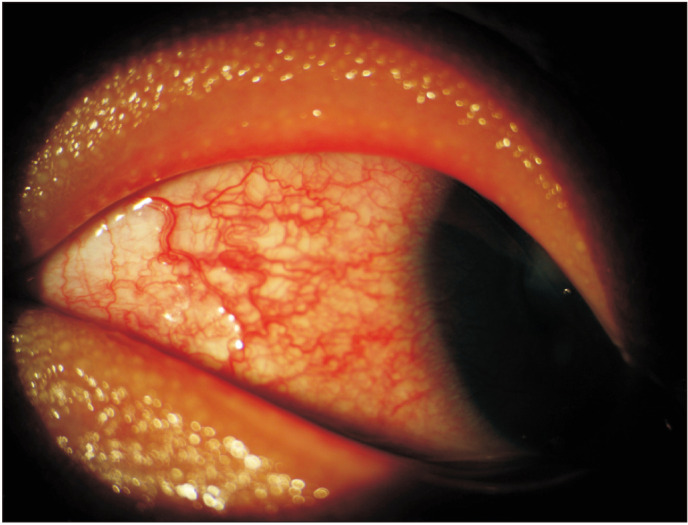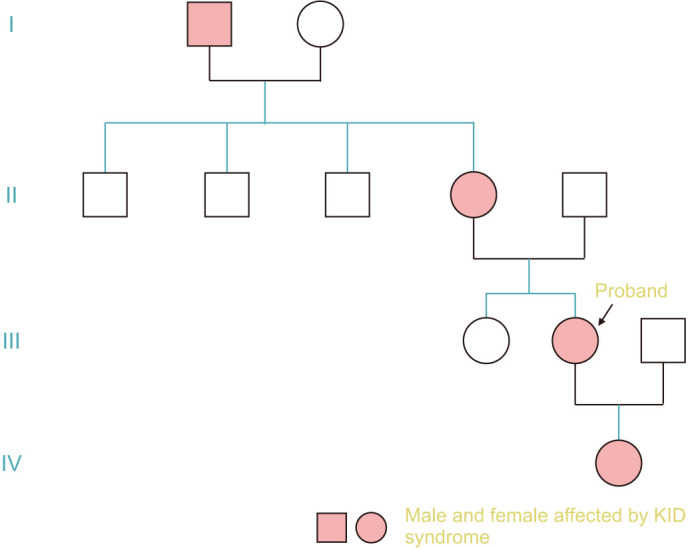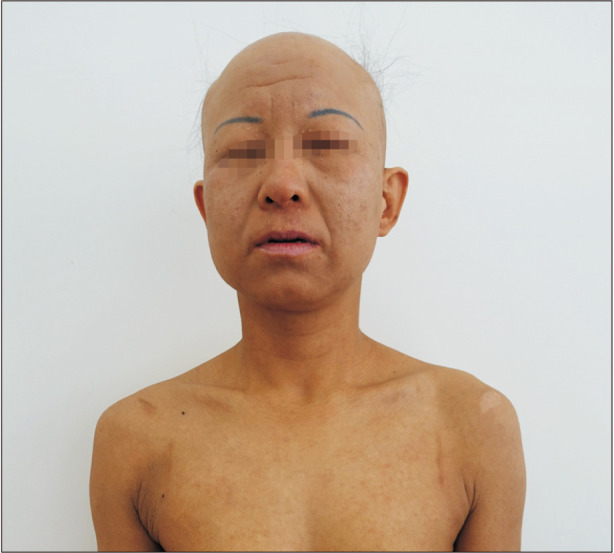The Clinical Manifestation of p.Asp50Asn Heterozygous Mutation of GJB2 Gene in 3 Members of a Family Is Similar to That of Clouston Syndrome.
IF 1.5
4区 医学
Q3 DERMATOLOGY
引用次数: 0
Abstract
Keratitis-ichthyosis-deafness (KID) syndrome has genetic heterogeneity, and the clinical manifestations of some patients may overlap with Clouston syndrome. A 34-year-old female patient came to our department with a complain of “sparse hair, rough skin, photophobia and deafness for more than 30 years.” We found that the proband and two other family members (57-year-old mother and 4-year-old daughter) had similar clinical manifestations: systemic hair loss, generalized skin hyperkeratosis, especially in the metacarpophalangeal area. Subungual hyperkeratosis, finger/toenail dystrophy, as well as photophobia and epiphora. According to the investigation, one of the family members also had similar clinical manifestations (grandfather of the proband) and he’s died. The other three members of the family had no hearing impairment, and all patients had typical nail dystrophy, hair loss and palmoplantar hyperkeratosis, similar like as seen in Clouston syndrome, so we suspected to diagnose the case as Clouston syndrome. However, after genetic testing, it was found that the proband, his mother and daughter all had p.Asp50Asn heterozygous mutations in the GJB2 gene, and no mutation was detected in GJB6. The modified diagnosis was KID syndrome.



家族3名成员p.Asp50Asn GJB2基因杂合突变的临床表现与克劳斯顿综合征相似。
角膜炎-鱼鳞病-耳聋(KID)综合征具有遗传异质性,部分患者的临床表现可能与Clouston综合征重叠。一名34岁女性患者来我科就诊,主诉“头发稀疏、皮肤粗糙、畏光、耳聋30多年”。我们发现先证者和另外两名家庭成员(57岁的母亲和4岁的女儿)有相似的临床表现:全身性脱发,全身皮肤角化过度,尤其是掌指骨区。趾甲下角化过度,手指/脚趾甲营养不良,以及畏光和眼显。经调查,其中一名家庭成员(先证者祖父)也有类似临床表现,已死亡。另外三名家庭成员均无听力障碍,且患者均有典型的指甲营养不良、脱发、掌足角化过度,与Clouston综合征相似,故我们怀疑诊断为Clouston综合征。但经基因检测发现先证者及其母亲、女儿GJB2基因均存在p.Asp50Asn杂合突变,GJB6基因未检出突变。修改后的诊断为KID综合征。
本文章由计算机程序翻译,如有差异,请以英文原文为准。
求助全文
约1分钟内获得全文
求助全文
来源期刊

Annals of Dermatology
医学-皮肤病学
CiteScore
1.60
自引率
6.20%
发文量
77
审稿时长
6-12 weeks
期刊介绍:
Annals of Dermatology (Ann Dermatol) is the official peer-reviewed publication of the Korean Dermatological Association and the Korean Society for Investigative Dermatology. Since 1989, Ann Dermatol has contributed as a platform for communicating the latest research outcome and recent trend of dermatology in Korea and all over the world.
Ann Dermatol seeks for ameliorated understanding of skin and skin-related disease for clinicians and researchers. Ann Dermatol deals with diverse skin-related topics from laboratory investigations to clinical outcomes and invites review articles, original articles, case reports, brief reports and items of correspondence. Ann Dermatol is interested in contributions from all countries in which good and advanced research is carried out. Ann Dermatol willingly recruits well-organized and significant manuscripts with proper scope throughout the world.
 求助内容:
求助内容: 应助结果提醒方式:
应助结果提醒方式:


